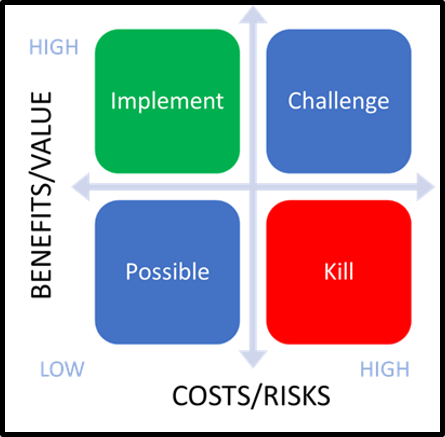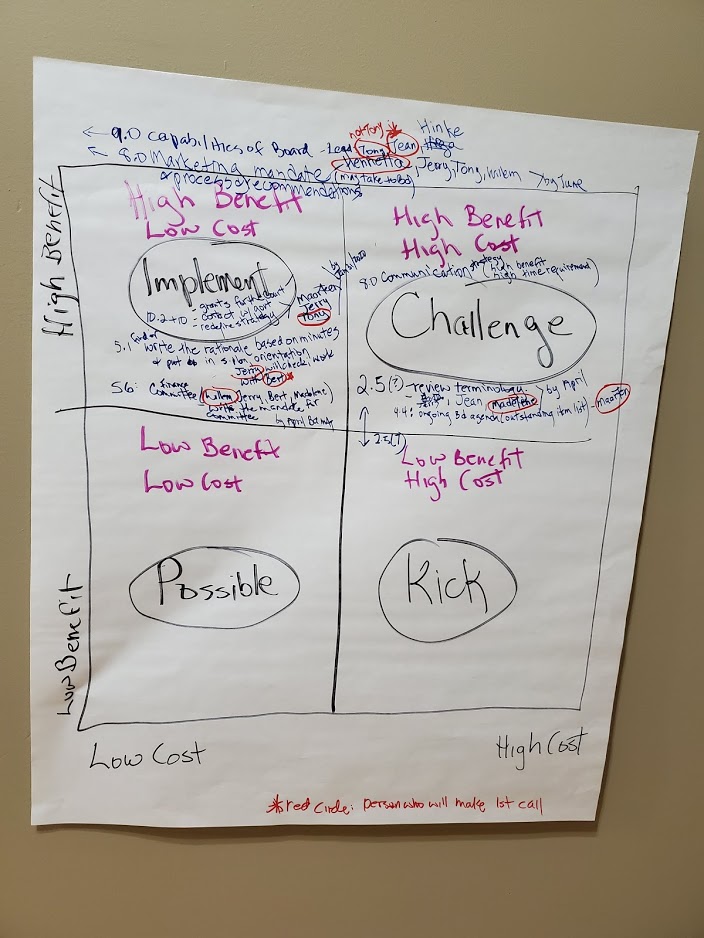“We could never have done this ourselves at a regular Board meeting,” said the chair of a non-profit society. One definition of facilitating is “to make an action or process easy or easier”. I have always thought this definition is over-simplistic (haha), yet, sometimes, that is what facilitators are asked to do. A group may not need complex or intricate designs and processes; they need help to do something in an easier way.
Recently, I facilitated a half-day session with a board of directors t o help them “untangle” three documents that had come to a decision and action point at the same time. The documents were:
o help them “untangle” three documents that had come to a decision and action point at the same time. The documents were:
- Revisions for their bylaws
- In-progress actions from their three-year strategic plan
- Recommendations from a comprehensive and extensive member survey
The board asked me to help them align the three documents so they knew what they should do first, when, and who should act. They, and their leadership staff, were too “close to the forest”; seeing each strategy, action, recommendation, and bylaw change as a separate tree and they couldn’t see the overall patterns.
The analogy that I thought of was of a large tangled, knotted ball of yarn. I assisted the board to gently and slowly pull out each string of yarn and then weave them together.
Here’s what I did.
- Clarifying outcomes for the session through storytelling and an ORID conversation
Before the session, I facilitated several one-hour preparation meetings with three board members to help them determine what they really wanted to achieve and what information they needed to address. I used a type of storytelling activity with each person describing the impact of the three documents on the organization over the past year, what she/he had done related to the three documents and how she/he felt about it. Using an ORID focus conversation https://bit.ly/2GvWSrh, we decided that they did not need to try to combine the actions for each of the three documents into one overall action plan. They were too distinct. Rather, we could take each document individually, prepare priorities, timelines, and roles, and then look at the overall effect.
From this clarity exercise, I could see the weight lift off shoulders and smiles come back on faces.
- Priority setting through a Benefit/Cost PICK Chart for the strategic plan
At the priority setting session, I used a Benefit/Cost PICK Chart to determine the priorities for the 22 uncompleted actions within the strategic plan. The Pick Chart is a Lean Six Sigma tool that is used to sort ideas. I used the two criteria of benefit and Cost. PICK stands for Possible, Implement, Challenge, and Kill (or use more non-violent words like Kick or Kibosh).
The board members said that seeing the actions categorized visually made it incredibly easy for them to determine what they needed to do. Everything was clearer and simpler. We then assigned a timeline and a lead person for each of the actions in the High Benefit/High Cost and High Benefit/Low Cost categories.

- ORID Conversation for the bylaws
For the bylaws, we held an ORID Conversation to determine the questions and outstanding concerns that each member had and then, assigned a small committee to seek expert advice and finalize the bylaws.
- Action Chart for the survey recommendations
For the survey recommendations, we categorized them into three broad areas with four or five major actions in each.
|
Action |
When |
Who |
The board of directors then took the charts and the record of the conversations and scheduled a board meeting to approve the plan. We found the end of the big ball of tangled yarn!



Brilliant idea! I love how you used the yarn to make a point and “tie” it all together! Thank you for sharing.